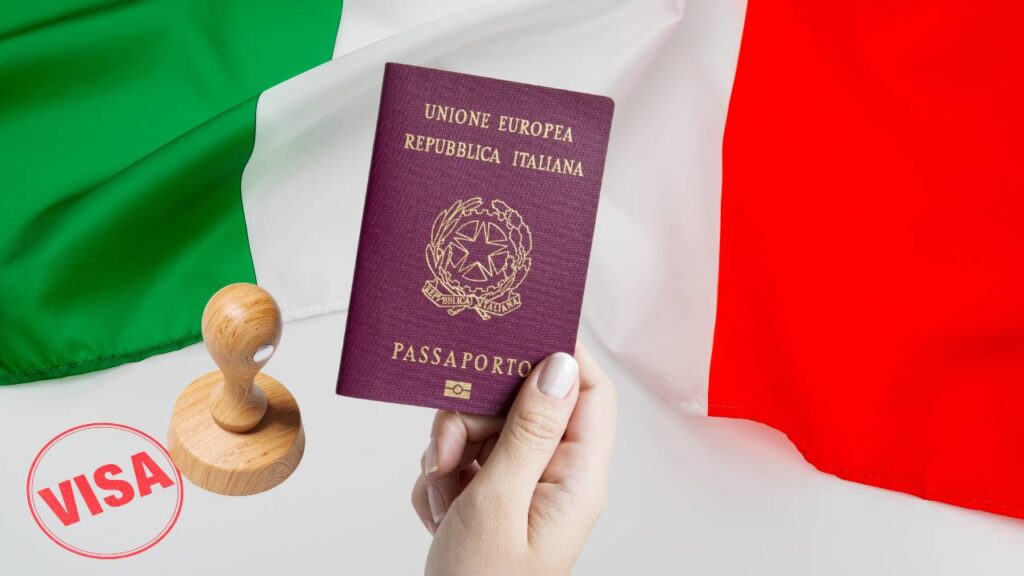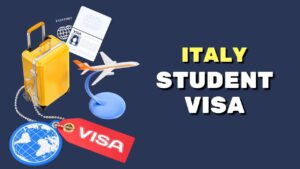For tourism, business, study, or any other purpose, understanding the Italy embassy visa process is essential to avoid unnecessary delays or complications. Italy attracts millions of visitors annually, thanks to its rich history, stunning art, mouthwatering cuisine, and vibrant culture. Italian government enforces strict visa guidelines to ensure security, control immigration, and uphold international agreements.
Aim to visit for a short holiday, attend academic programs, work, or join family, being well-informed about the visa requirements, appointment system, and processing timelines will help you navigate the process more smoothly.
Proper preparation of your documents and awareness of embassy procedures not only reduces the risk of last-minute setbacks but also increases the likelihood of obtaining visa approval on your first attempt. Taking time to research and understand the process saves you stress and potentially costly delays later.
What Is an Italy Embassy Visa?
An Italy embassy visa is an official authorization issued by the Italian embassy or consulate in your country, permitting you to enter Italy legally for a specified period. This visa outlines your length of stay, purpose of travel, and number of entries allowed. Since Italy is part of the Schengen Agreement, a Schengen visa usually grants access to all 26 member countries, enabling seamless travel across borders without additional permits during the visa’s validity.
The embassy thoroughly examines each application to verify that travelers comply with immigration laws and security policies. Therefore, providing complete, accurate, and honest information is vital. Understanding whether your visa permits single or multiple entries or if it can be extended in Italy itself will help you plan your travel itinerary effectively. It is important to remember that violating visa terms, such as overstaying, can lead to fines, future visa refusals, or deportation.
Types of Italy Embassy Visas
Italy offers a variety of visa categories to suit different travel purposes and lengths of stay. Selecting the correct visa type ensures you provide the appropriate documents and understand your travel limits.
Schengen Visa (Short Stay Visa – Type C):
This is the most common visa for travelers visiting Italy for tourism, business meetings, cultural events, or visiting family and friends. It allows stays of up to 90 days within any 180-day period across Schengen countries. This visa strictly prohibits employment or long-term studies, although short courses may be permitted. The Schengen visa application requires clear travel plans and proof of accommodation.
National Visa (Long Stay Visa – Type D):
If you plan to stay in Italy for more than 90 days, you must apply for a national visa. This category includes students, workers, researchers, family reunification applicants, and retirees. Unlike the Schengen visa, this visa requires an application from your home country before travel and may require additional clearances. It allows you to apply for a residence permit once in Italy.
Student Visa:
If you gain admission to a recognized Italian educational institution, the student visa allows you to study and work part-time up to 20 hours per week. Applicants must prove enrollment, financial means, accommodation, and health insurance.
Work Visa:
For employment, you need a valid job offer and a Nulla Osta (work permit) issued by Italian labor authorities. Your employer coordinates with immigration to obtain authorization before you apply. Different work visa types exist depending on job sector and contract duration.
Family Reunion Visa:
This visa permits immediate family members to join relatives legally residing in Italy. Applicants must prove family ties, legal residency of the sponsor, and the sponsor’s financial capacity to support the family member.
Knowing the specific visa type you need ensures you submit accurate documentation and understand the rights and limitations linked with your stay, which helps avoid application rejection or visa misuse.
Italy Embassy Visa Requirements
The Italian embassy requires a comprehensive set of documents to verify your identity, travel intent, financial stability, and ties to your home country. Consular officers scrutinize each piece of evidence to confirm that your travel is legitimate and that you intend to return after your visit.
1. Valid Passport
Your passport must be valid for at least three months beyond your planned exit from the Schengen Area and must have at least two blank pages for stamps. It should have been issued within the last 10 years. Submitting a damaged or nearly expired passport will cause automatic rejection. Always double-check your passport validity well before applying for your visa, and renew it if necessary.
2. Completed Visa Application Form
The visa application form must be filled in completely and accurately, with no missing fields unless clearly indicated. Many Italian embassies offer digital submission forms to reduce errors and speed up processing. The information you provide must match supporting documents exactly. Any discrepancy can lead to delays or outright rejection. Don’t forget to sign the form physically or digitally to confirm the truthfulness of your information.
3. Recent Passport Photos
You need to submit biometric passport-sized photos taken within the last six months. These photos must meet specific criteria such as size (usually 35×45 mm), plain white background, no shadows, and a neutral facial expression with your mouth closed. Wearing glasses is generally discouraged unless medically necessary. Poor quality or non-compliant photos often cause application delays.
4. Travel Itinerary
A detailed travel itinerary includes your confirmed round-trip airline tickets, travel dates, and proof of accommodation for your entire stay. Embassies typically do not accept tentative bookings or flexible travel plans because they cannot verify that you will leave the Schengen area after your visit. Including an itinerary also demonstrates organization and intent, which positively influences your application.
5. Proof of Financial Means
You must prove that you have sufficient funds to support yourself throughout your stay in Italy. Acceptable proof includes recent bank statements (usually from the past 3-6 months), pay slips, tax returns, or sponsorship letters if someone else finances your trip. The embassy expects you to show a minimum balance depending on your stay length and cost of living estimates, so check the specific requirements for your country.
6. Travel Insurance
Travel medical insurance with a minimum coverage of €30,000 is mandatory. It must cover emergency medical treatment, hospitalization, and repatriation for your entire duration in all Schengen countries. Only policies from recognized providers count, and it is advisable to keep a copy of your insurance certificate ready for submission.
7. Proof of Accommodation
You must submit valid proof of lodging for your entire trip, which could be hotel bookings, rental agreements, or an invitation letter from an Italian host with a copy of their ID or residence permit. The embassy wants to ensure you have a stable place to stay and that your accommodation aligns with your itinerary.
8. Purpose-Specific Documents
Additional documents vary depending on the visa type. For example, business travelers must provide invitation letters from Italian companies and registration certificates; students must submit university admission letters, proof of tuition payment, and accommodation details; workers must include employment contracts and Nulla Osta permits. These documents demonstrate the legitimacy of your visit.
9. Cover Letter
A well-written cover letter explaining your travel purpose, itinerary, and intent to return to your home country adds a personal touch to your application. This letter helps consular officers better understand your plans and assess your credibility. Include relevant details such as your ties to your home country, employment status, or family obligations.
10. Proof of Civil Status
For family reunification visas or applicants traveling with dependents, submit official marriage, birth, or relationship certificates. Some of these documents may require legalization or an apostille to be valid internationally. Confirm with the embassy which documents need special certification.
Submitting a complete and well-organized application package helps avoid unnecessary delays or refusals and speeds up the processing of your visa.
How to Book an Appointment for Italy Embassy Visa
Booking an appointment at the Italian embassy or consulate is a mandatory step to submit your visa application in person. Many countries outsource this service to authorized visa application centers such as VFS Global or TLScontact, which help streamline the process.
Step-by-Step Appointment Booking:
Visit the Official Website:
Always use the official embassy or consulate website or their authorized visa center’s portal. This ensures you avoid fraudulent sites or excessive service fees. Most official sites have clear instructions on the booking process.
Register and Create a Profile:
Creating a personal account allows you to book, reschedule, or cancel appointments and track your application status online. Keep your login details safe and check your email regularly for notifications.
Choose Visa Type and Office Location:
Select the visa category based on your travel purpose and the embassy or consulate jurisdiction that serves your area. In some countries, multiple consulates handle visa applications based on residency.
Pick a Date and Time:
Appointment slots fill up quickly, especially in peak travel seasons like summer or holidays. Experts recommend booking at least one to two months ahead to secure your preferred date and avoid rush.
Confirm and Print Appointment Slip:
After successfully booking, print your appointment confirmation receipt. You must carry this document to your appointment along with your application materials.
Tips for Appointment Day:
Arrive at least 15-30 minutes early to clear security and check-in. Bring all required original documents and photocopies neatly arranged. Pay the visa center’s service fees, if applicable, at the time of your appointment. Also, stay updated on any COVID-19 related rules such as mask requirements or health declarations. Being punctual and well-prepared increases your chances of a smooth application submission.
Italy Embassy Visa Processing Time
Visa processing time varies widely depending on visa type, nationality, embassy workload, and seasonal factors. Knowing expected timelines allows you to plan your travel carefully and avoid last-minute issues.
General Processing Periods:
Schengen Short-Stay Visa: Processing typically takes about 15 calendar days from the appointment date. During peak seasons or due to security checks, processing can extend to 30 or even 60 days. The embassy only starts processing once it has all your documents and biometric data.
National Long-Stay Visa: These visas require thorough background checks and sometimes coordination with Italian immigration authorities, so processing may take between 30 to 90 days. Early application is essential to avoid missing study or work start dates.
Student and Work Visas: These often involve additional verification from universities or employers and can take several weeks to months. Make sure to apply at least 3 months in advance to secure your visa on time.
Factors That May Delay Processing:
Incomplete or inconsistent documents prompt embassies to request additional paperwork, delaying decisions. Background checks and security clearances add time. National holidays and embassy staff shortages can extend waiting times. Changes in immigration policy or diplomatic relations sometimes cause temporary processing suspensions. Always check the embassy’s website for the latest updates and submit your application well in advance to mitigate these risks.
Additional Tips for a Successful Italy Embassy Visa Application
To improve your chances of obtaining your Italy embassy visa quickly and without hassle, follow these expert tips:
- Submit Complete and Organized Documents: Use the embassy checklist and double-check all your paperwork. Missing even one document can cause delays or rejection.
- Be Truthful and Consistent: Always provide honest information and ensure that all your documents and application details align. Contradictions can lead to suspicion and denial.
- Show Strong Financial Stability: Submit clear and recent bank statements or sponsorship letters to prove you can financially support yourself during your stay.
- Include Previous Travel History: Attach copies of old visas and entry/exit stamps to demonstrate compliance with visa rules on past trips, especially Schengen or European travel.
- Prepare for Possible Interviews: Some embassies conduct interviews to verify your plans and ties to your home country. Practice answering questions clearly and confidently.
- Keep Copies of Everything: Always retain copies of your submitted application and appointment confirmations for your records and potential follow-ups.
Italy Tourist Entry Requirements: What Every Traveler Must Know
Following the guidelines and tips shared above will help you unlock the doors to experience Italy’s rich culture, breathtaking landscapes, and unforgettable experiences worry-free.
FAQs
1. What is an Italy embassy visa, and do I need one to visit Italy?
An Italy embassy visa is an official permission issued by the Italian embassy or consulate that allows you to enter Italy for a specified purpose and duration. Most travelers from countries outside the European Union and Schengen Area require this visa to enter Italy, especially for stays longer than 90 days or for specific activities like work or study. Citizens of visa-exempt countries can visit Italy for short stays (up to 90 days) without a visa but must still comply with entry requirements.
2. How do I know which type of Italy visa I should apply for?
The type of visa depends on your travel purpose and length of stay. If you’re visiting Italy for tourism, business, or family visits for less than 90 days, apply for a Schengen short-stay visa (Type C). For longer stays, such as studies, employment, or family reunification, you must apply for a national visa (Type D). It’s essential to choose the correct visa to avoid application rejection or legal complications during your visit.
3. What are the key documents required for an Italy embassy visa application?
Typical documents include a valid passport, completed visa application form, recent passport-sized photos, confirmed travel itinerary and accommodation proof, travel medical insurance covering the Schengen area, proof of financial means, and purpose-specific documents such as employment contracts or university admission letters. Always consult the embassy’s official checklist for your visa type, as missing or incorrect documents often cause delays or refusals.
4. How can I book an appointment for submitting my Italy visa application?
Most Italian embassies or consulates require you to book an appointment online via their official website or through authorized visa application centers such as VFS Global or TLScontact. You need to create a profile, select your visa type, choose the nearest embassy or consulate, and pick an available date and time. It’s advisable to book your appointment well in advance, especially during peak travel seasons.
5. How long does it take to process an Italy embassy visa?
Processing times vary by visa type and embassy workload. Typically, a Schengen short-stay visa takes about 15 calendar days but can take up to 30 or 60 days in some cases. Long-stay visas (Type D) may require 30 to 90 days or longer due to additional background checks and coordination with Italian authorities. Applying early allows ample time to handle any delays.
6. Can I work or study in Italy on a Schengen short-stay visa?
No, the Schengen short-stay visa (Type C) does not allow you to work or enroll in long-term study programs in Italy. It is strictly for tourism, business, family visits, or similar short-term purposes. For work or study, you must apply for the appropriate national visa (Type D) and obtain necessary permits before arrival.
7. Is travel insurance mandatory for obtaining an Italy visa?
Yes, travel medical insurance with a minimum coverage of €30,000 is mandatory for all Italy embassy visa applicants. The insurance must cover emergency medical expenses, hospitalization, and repatriation for the entire duration of your stay in all Schengen countries. Without valid insurance, your visa application will be rejected.
8. What happens if my Italy embassy visa application is rejected?
If your visa application is rejected, the embassy will provide you with a written explanation detailing the reasons for denial. Common causes include incomplete documentation, insufficient financial proof, doubts about your return intent, or security concerns. You can appeal the decision within a specified period or reapply with a more complete and convincing application.
9. Can I extend my Italy visa after arriving in Italy?
Short-stay Schengen visas usually cannot be extended except under exceptional circumstances such as medical emergencies or humanitarian reasons. Long-stay national visas (Type D) may allow you to apply for a residence permit (Permesso di Soggiorno) in Italy to extend your stay legally. Extensions require timely applications and valid reasons supported by documentation.
10. Are there any tips to increase my chances of getting an Italy embassy visa approved?
Yes, to maximize your chances: submit a complete and well-organized application, provide honest and consistent information, prove strong ties to your home country (such as employment or family), demonstrate sufficient financial means, and comply with all visa requirements. Arriving prepared for any interview and submitting all required documents on time will also enhance your application’s success.



